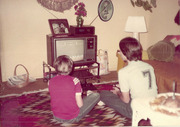tv [untitled] September 25, 2010 10:30pm-11:00pm PST
11:30 pm
in the state's goals in terms of greenhouse gas reductions. before we have a resolution, the board of supervisors passed in early may, it is just for you to discuss if you like to consider passing a similar resolution. are there any questions? >> any questions for our trusty staffer? the question before us, should they sign on to this resolution? we might want to take lessons from the board of supervisors who already has demonstrated that this is a worthy resolution would you like to make the motion? commissioner avalos: im otion that - i motion that lafco signs on against prop 23.
11:31 pm
commissioner schmeltzer: second. supervisor mirkarimi: any discussion? any public comment? >> a good afternoon, commissioners. from the san francisco green party and representing the coalition on community choice. as far as proposition 23 goes, that is a no-brainer. specifically to what staff raised in the amendments, these are brand new. please e-mail me and other advocates right away so that we can look over the amendments and make sure that the environmental community and the advocate community is comfortable with them. to the specifics, there is a
11:32 pm
little rest their, the rating issue. let's just make sure that if we're going to make that change, that we have a point system within the new structure that strongly favors somebody that has the strongest financial status so that we have this project backed up and we don't read the same problem that we ran into before. dividing at customer service, do we need to do, but that raises concerns for me personally. as director campbell said, when you have two different firms handling to different parts of a project, there is a tendency for them to point fingers at each other. i would agree that we have to be careful about where we go with dividing things out, if the contractor that wins this bid
11:33 pm
goes on to win the next thing that we are envisioning, which is one comprehensive rfl, it will be more important for the contractor to handle customer service as well because it will be so much more involved of the project. we at least want to make sure that in the second stage, it is reopened and we try to join them together. what staff as wanting to do, favoring having one central contractor do everything together is probably the best course. i think you should look at the 2007 ordinance, because a think it might have something that was not covered by the last amendment. as far as the next steps, a couple of years ago, we indicated that studies need to be done to identify the
11:34 pm
locations and the potential assets of the city for a bill out phase. that needs to be done now. we are going to run a the same problem we ran into a couple of months ago and not be able to do this as a comprehensive project. [bell] we are going to be behind the ball again, and that is not good. supervisor mirkarimi: any other public comment? public comment is closed. without objection, can we take that resolution and informal suggestions? seeing no objection, those items events. next item. >> report on the solar program. supervisor mirkarimi: ok. >> hi, again. commissioner schmeltzer also
11:35 pm
request lafco staff to research on the solar program that we got wind of. it is a program being conducted by the largest publicly owned utility in the state called public service electric and gas company. they are installing 200,000 solar units that consist of a solar panel and a communications system on utility poles and street lights throughout the state of new jersey. this program is expected to produce 40 megawatts of energy when it is completed in 2012. and something in florida is looking at a similar program, testing the similar solis system produced by a company in new jersey, and it just got with
11:36 pm
the that there are representatives here that might be able that answer some of your questions if you have a. a little bit of background about these units. do we have the image up? that is what it looks like. pretty self-explanatory. from my research, i found that the cost is about $6.44 for each what produced -- watt produced. in terms of financing, they plan on adding 10 cents to each customer's bill that will maybe go up to 35 cents by 2013. also, the program is financed by bonds and equities by companies selling energy in the wholesale market.
11:37 pm
some of the benefits that we might actually take for clean power staff obviously the simplicity in speed of it. it doesn't require acquiring land or dealing with regulations of putting the solar on people's roofs. it doesn't require power lines or infrastructure. as we are putting these things up on the polls, but could be recuperating cost. in the local job factor, i think they estimate they can create about 100 jobs with each contract they have. and lastly, positive visibility it will create. some of the questions that we might want to talk about today or just something for us to
11:38 pm
think about in the future includes how many of these we can put this on if you think about doing this. the city doesn't own transmission lines, but we do have streetlights. that could be a possibility. the city owns some of the lines that go a little out of the city, i believe. that could be another opportunity. also, jason of lafco staff told us to look into a standalone solar program that would be a system connected into the grid. that would be something that would influence this program, because we would have to decide where to put the street lights and where they would go into the grid.
11:39 pm
lastly, i wanted to mention that do jersey is using a smart red technology for the program, which is something that we might or might not want to use. it's just a question of how we would monitor the system if we were going to use that technology. just to clarify, these type of the installations feed directly into the grid. there needs to be no new transmission lines per anything like that. any questions? the next step, we just want to hear your thoughts about this. we were just asked to put some brief information together. we also haven't talked to the sfpc about the viability. we just want to hear if we should look into this? >> first, i want to thank you
11:40 pm
for unearthing this information. knowing what i know of it, a think it is very worthwhile to pursue to see how this might factor in to the larger design and strategy of implementing a clean energy program. especially the way it is exhibited here, how fast as the new jersey program? >> i know that pfe & g is the largest utility in the state, they have something like 200,000 utility poles. i read somewhere that it is the largest pulled out solar program in the world.
11:41 pm
supervisor mirkarimi: do you have an idea of commercial verses' residential benefits from this? a percentage of where the energy is being channeled? >> i think it is like pg&e. anybody using their power would benefit from this technology. >> but no idea of percentages? >> no. commissioner schmeltzer: i want to supplement what commissioner mirkarimi just said. i did a very little bit of looking into it when i was in new jersey this summer and saudis about it. it was noticeable, which is what triggered by interest. it was announced at the
11:42 pm
beginning of 2009, and by june, all you had to do was be a new jersey for a few minutes and you saw these solar panels everywhere on utility poles. they seem to have moved pretty quickly. i don't know how many of the 200,000 were up or if it was just installed in one corner of new jersey where i happened to be, but it seemed like it was a fairly fast moving program and they already owned the site. it didn't have to spend a lot of time getting access or transmission agreements finished. i think it would be terrific to talk more about either finding out from pfe & g which is the
11:43 pm
equivalent of a statewide pg&e, for the whole state. but whether san francisco puc or part of a different program would be able or interested in doing something like this, whether there is that kind of capacity or willingness. while it is great to have a big solar installation, pursuing projects like that, we'd all the different pieces and all the different tools available to us to beat a renewable energy challenge. commissioner avalos: thank you for going into jersey. i support -- [unintelligible]
11:44 pm
antennas have been going up to the city, we don't have much undergrounding in my district. you see some of the new antennas, and often they will be able to get out into the sidewalks. there are facilities that stickout, the poles themselves will have wires crisscrossing back-and-forth across the street, and it is really dense.
11:45 pm
his supervisors and residents of the city as well [unintelligible] i guess, in this case, solar infrastructure as well. it gets to be a lot of blocking out of the sky at some point, certainly, i think it is felt in some districts as well as others. supervisor mirkarimi: commissioner dufty has history with the underground staff -- taskforce. commissioner dufty: there is a disparity about how the underground is distributed in the city.
11:46 pm
the variants is tremendous, but think colleagues recall that i sought to have some funding dedicated to focus on these inequities and try to restart the program because we have expended all of the credits, i believe through 2019. there were increased costs that were accumulated in the program that was begun with the settlement of a lawsuit, in the city attorney. we have come to the end of that. we have done some very limited additional underground work, like light rail, for example. right now, we're really looking at how to restart the program,
11:47 pm
and i do share commissioner avalos's concerns about seeing apparatuses that are being dropped on polls without input. we want more readable and applications. i want a somewhat concerned that could exacerbate that problem. supervisor mirkarimi: is a complete removal, or do the polls remain? commissioner dufty the poles are removed. in that case, the objective is to eliminate the wires underground that have a number of benefits to it. and they apply a utility user's
11:48 pm
tax dedicated to undergrounding, but given the climate and the attitude towards revenue measures, hopefully it is something we can get a dedicated source of funding and we can work towards that as members of the task force tried to think of ways to get the program going. the west side of town, the southeast portions of town, supervisor mar's portion of town has almost no undergrounding. commissioner schmeltzer: thank you, it occurs to me that there must be issues of undergrounding in new jersey as well, and maybe they have thought about what their plan is to make sure they don't lose their investment as different neighborhoods or
11:49 pm
community's move to or from undergrounding. perhaps there has already been some thought that has got into this. we do have other things that are disconnected, or easily connected such as street lights or other things that are connected through electricity. the underground wires, of course, are still right there. there may be other ways to achieve the same idea just using different types of polls -- supervisor mirkarimi: or other poles. commissioner campos: we need to eliminate the city in the nighttime. i am working on legislation, electrical poles that we try to
11:50 pm
be consistent on, something we are to pursue that is really in the spirits of grow work. supervisor mirkarimi: i think you have some decent feedback that explains our interest in hearing more about the prospects of this program, but with certain guidelines and other issues that are city-wide it because there has been an outstanding frustration with trying to implement the undergrounding of the utility poles which has been slow. knowing that, it would be worthwhile to continue to get more data and see how this
11:51 pm
might really benefit san francisco. >> we will have more discussions to see if this is even a viable program. >> i think it is important that this continue to be a joint investigation. it would be nice to see some financial particulars on this as well. no further comments, colleagues? public comment? come on up. >> my name is chris chapel, i can answer virtually all of your questions. we are located in new jersey and we are deploying 200,000 solar units with smart grid capability. in california, we're working
11:52 pm
with san diego gas and electric, where alert -- we're working with los angeles, too. as opposed to putting an led light on the pole, putting up a solar panel with a battery is dangerous. we have the bureau take the daytime generation through the solar panel, so it back during peak hours, and by the power back at the lower rate at night. in essence what they're doing, they're almost getting a credit back. we can work right with street lights, metal, aluminum, fiberglass. the grid is everywhere. it is here in this building, at every street light, every poll, every utility box. on the report, there were some
11:53 pm
questions about utilizing wireless carriers or working with verizon or at&t. the technology is open, integration is very simple. currently, the city of los angeles is installing 50,000 lives that will generate power. there is no permit or these upfront design and engineering costs. i spent 15 years with pg&e doing projects, and tatarstan the whole game. for you guys, we would install the manufacturing facility here in the san francisco area. we would generate -- we're
11:54 pm
working with pg&e on this as well, about 400 permanent jobs. in addition to putting green out there for the public, we're creating jobs at the same time. you have to manufacture in your backyard and buy locally. i think those were in it. i tried to grab all the questions i could. any other questions you guys may have?ns >> you mentioned 50,000 of these installations. did you say that is 10 megawatts? >> about 10 megawatts. on top of that, i was going to say, we could rollout that commission and get online about 1.1 megawatts. when you talk about pg&e and 250-megawatt plants, the years and years. my kids will never see this.
11:55 pm
as far as costs, we use a level lies cost of energy where we compete and compare rooftop solar. we compare centralized field solar, and that level lies cost of ownership is a lot less than traditional solar field because there's less pre-work front end loading that needs to be done. literally, you figure out where your whole dark, we go up, do a quick survey, and are up in 30 minutes. the crew can put this in 15 or 30 minutes. >> could we pilots the residential and commercial -- >> to answer your other question, it is for the city. it is not for residents. i can get you guys a couple of units, probably two or three at
11:56 pm
no cost, and you can take a look at that. that is how we get people engaged to look at it. i think it is very well technology, simple to install. very easy to commission. >> ic light bulbs going off. >> i have a problem about the balboa bart station, the biggest transit hub in the city, and i did not know of solar would be a good way to get power up there to do it. there are places where we could do a pilot, and i would be supported. >> the state of california, throughout the highways, all the emergency telephones are solarized. those phones, if you are stranded, distressed motorists, those are also will rise, i believe, for the most part now, i believe it is similar. >> we are working with the
11:57 pm
california which california the form of transportation. those are the battery once. to be honest, it is not a real cool thing for people to be walking under a big battery. if it leaks or if it drops, that is not a good thing. los angeles is very afraid of that, so they were testing the "los angeles times lights with the sow with things on them, and you have this really sexy little box, and this battery that is this big. kind of takes away from it. "los angeles times programs are good. they have 34% reduction efficiencies. we're looking at getting credit. one is reducing the bill, and that is putting green power on the grid. >> -- supervisor mirkarimi: why don't we establish a follow-up meeting? i will ask my staff to help facilitate that, and we will see what some of the possibilities
11:58 pm
are in furthering this discussion. look forward to more information. the next speaker please. >> good afternoon, again, commissioners. wanted to lend some strong constructive criticism. the first i would have for the company itself and for the city, and that is that you will find that in this area, those smart grits and wireless signals are something that the public are really up in arms about, especially if the strikers would be run by pg&e corporation, so i would strongly recommend that if you go forward with this, you not only make it a city's margaret run by the city, but also, instead of using a wireless smart great, there is another technology where you use the power lines themselves as a carrier for a signal. it is not as robust, but it
11:59 pm
would probably go over with the public a lot better. you should consider that the public is going to write up and oppose you if you do not take these things into account. as far as the concept itself, the one really strong concern i have is that i read the open court examiner" article about this, and they said the new jersey is getting 40 megawatts for $200 million -- the "examiner" article. the price we are trying to get as $1 million a megawatt. that is a pretty dramatically higher price, so we need to figure out what is up with that. that kind of points to me. if we are going to go, they stand alone privately, installed solar system. we are probably in much better territory to try to figure out a way to try to take the opportunity to do this rapid rollout because it sounds like a gr
64 Views
IN COLLECTIONS
SFGTV: San Francisco Government Television Television Archive
Television Archive  Television Archive News Search Service
Television Archive News Search Service 
Uploaded by TV Archive on

 Live Music Archive
Live Music Archive Librivox Free Audio
Librivox Free Audio Metropolitan Museum
Metropolitan Museum Cleveland Museum of Art
Cleveland Museum of Art Internet Arcade
Internet Arcade Console Living Room
Console Living Room Open Library
Open Library American Libraries
American Libraries TV News
TV News Understanding 9/11
Understanding 9/11




























